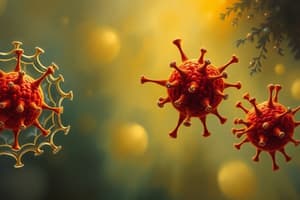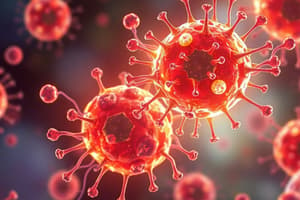Podcast
Questions and Answers
Which cells primarily produce type I interferons?
Which cells primarily produce type I interferons?
- Macrophages
- CD4 T Cells
- Dendritic Cells
- A variety of cells (correct)
What is the role of interferons in response to viral infections?
What is the role of interferons in response to viral infections?
- Inhibit macrophage function
- Promote bacterial growth
- Induce cells to undergo proliferation
- Activate antiviral defenses (correct)
Which of the following statements about NK and NKT cells is correct?
Which of the following statements about NK and NKT cells is correct?
- NKT cells are primarily responsible for producing type I interferons.
- Both NK and NKT cells originate exclusively from the thymus.
- NK cells and NKT cells have distinct functions in the immune response. (correct)
- NK cells are structurally similar to NKT cells.
Where are primary immune organs located in vertebrates?
Where are primary immune organs located in vertebrates?
How do NK cells interact with macrophages and dendritic cells?
How do NK cells interact with macrophages and dendritic cells?
What type of immune response does IFN-γ primarily influence?
What type of immune response does IFN-γ primarily influence?
Which of the following is a unique feature of the adaptive immune system?
Which of the following is a unique feature of the adaptive immune system?
Which signaling pathway is induced by type I interferons during viral infections?
Which signaling pathway is induced by type I interferons during viral infections?
What is primarily activated by IFN in the immune response?
What is primarily activated by IFN in the immune response?
Which type of immunity is Type 1 immunity primarily associated with?
Which type of immunity is Type 1 immunity primarily associated with?
What is the primary function of dendritic cells in the lymph node?
What is the primary function of dendritic cells in the lymph node?
What is the main role of NK cells in the immune system?
What is the main role of NK cells in the immune system?
What happens to the plasma cells after they are formed in the lymph node?
What happens to the plasma cells after they are formed in the lymph node?
What do Killer activation receptors (KARs) on NK cells recognize?
What do Killer activation receptors (KARs) on NK cells recognize?
In which part of the spleen is red pulp found, and what is its function?
In which part of the spleen is red pulp found, and what is its function?
How do Killer inhibition receptors (KIRs) function on NK cells?
How do Killer inhibition receptors (KIRs) function on NK cells?
What occurs when NK cells and macrophages interact at an infection site?
What occurs when NK cells and macrophages interact at an infection site?
What is the role of helper T cells in the lymph node?
What is the role of helper T cells in the lymph node?
What is the significance of the marginal zone in the spleen?
What is the significance of the marginal zone in the spleen?
What unique property do Natural Killer T (NKT) cells possess?
What unique property do Natural Killer T (NKT) cells possess?
What is a primary consequence of activated cytotoxic NK cells killing dendritic cells?
What is a primary consequence of activated cytotoxic NK cells killing dendritic cells?
Which of the following accurately describes the tissue layers of the spleen?
Which of the following accurately describes the tissue layers of the spleen?
How do NK cells retain memory of pathogen encounters?
How do NK cells retain memory of pathogen encounters?
How do antibodies travel to the infected tissue after being secreted by plasma cells?
How do antibodies travel to the infected tissue after being secreted by plasma cells?
Where do dendritic cells move after they become residents in lymph nodes?
Where do dendritic cells move after they become residents in lymph nodes?
What is the effect of type I interferon on NK cells?
What is the effect of type I interferon on NK cells?
What is the primary function of pattern recognition receptors (PRRs) in the innate immune system?
What is the primary function of pattern recognition receptors (PRRs) in the innate immune system?
In which organs do immune cells primarily develop?
In which organs do immune cells primarily develop?
What role do CD4+ helper T cells play in the immune response?
What role do CD4+ helper T cells play in the immune response?
What occurs in the germinal centers of lymph nodes?
What occurs in the germinal centers of lymph nodes?
How do lymphocytes that are not activated by specific antigens proceed after leaving the lymph node?
How do lymphocytes that are not activated by specific antigens proceed after leaving the lymph node?
What is the primary site of antigen processing for lymph-borne pathogens?
What is the primary site of antigen processing for lymph-borne pathogens?
Which type of T-cells directly attack and destroy infected cells?
Which type of T-cells directly attack and destroy infected cells?
What is class switching in the context of B-cell maturation?
What is class switching in the context of B-cell maturation?
What is the fate of lymphocytes activated by a specific antigen within the lymph node?
What is the fate of lymphocytes activated by a specific antigen within the lymph node?
What distinguishes the adaptive immune system from the innate immune system?
What distinguishes the adaptive immune system from the innate immune system?
What is primarily found in the periarteriolar lymphoid sheath (PALS) surrounding the central arteriole?
What is primarily found in the periarteriolar lymphoid sheath (PALS) surrounding the central arteriole?
Which component of the lymphoid follicles contains macrophages and differentiating B cells?
Which component of the lymphoid follicles contains macrophages and differentiating B cells?
What unique feature do liver-resident natural killer (NK) cells possess?
What unique feature do liver-resident natural killer (NK) cells possess?
What aspect differentiates NKT cells in sooty mangabeys from those in other species?
What aspect differentiates NKT cells in sooty mangabeys from those in other species?
In the lymphoid structure, what does the perifollicular zone primarily contain?
In the lymphoid structure, what does the perifollicular zone primarily contain?
What potential role might liver-resident NK cells play according to current research?
What potential role might liver-resident NK cells play according to current research?
What are the regions comprised in lymphoid follicles?
What are the regions comprised in lymphoid follicles?
Which cells are predominantly found near the central arteriole in the PALS?
Which cells are predominantly found near the central arteriole in the PALS?
Flashcards are hidden until you start studying
Study Notes
Instructor Information
- Office Hours: Tuesday, 4-5 pm (virtual) and Thursday, 4-5 pm (316J)
- DITKI due: Wednesday by 12:59 pm
- Adaptive Immunity- Cellular (with quiz)
- Re-view Thymus, Spleen, and Lymph Nodes (no quiz)
Objectives
- Identify the locations of adaptive immune system receptors within the context of cells.
- Correlate the ligands and receptors of two types of immune cells, focusing on their signaling outcomes (KIR & KAR).
- Compare and contrast NK and NKT cells.
- Describe the interplay between NK cells, macrophages, and dendritic cells in initiating an immune response.
- Outline the movement of lymphocytes throughout the body, highlighting key anatomical features.
- Differentiate the adaptive immune system from the innate immune system, emphasizing specific characteristics of the adaptive system.
- Recognize and describe the microenvironments where adaptive immune cells mature, and the adaptive immune response develops.
- Identify primary and secondary immune organs in vertebrates, clarifying their functions in relation to the adaptive immune system.
Immune Response Refreshers
- Interferons are a family of cytokines specifically designed to induce cellular resistance against viral infections.
- Interferons are rapidly produced during viral PAMP interactions with PRRs.
- The primary interferons are IFN-α and IFN-β (type 1 interferons).
- They induce cells to activate antiviral defenses such as the RNA-dependent protein kinase pathway and apoptotic (programmed cell death) pathway.
- IFN-γ (type II interferon) is structurally and functionally distinct from type 1 interferons but is produced by activated lymphocytes such as CD4 T cells, CD8 T cells, NK cells, and ILCs.
- Primarily activates macrophages in both innate and adaptive immunity.
NK & NKT Cells
- NK cells are circulating lymphocytes of the innate immune response, providing an early defense against viral infections.
- NK cells kill certain virally infected cells and tumor cells without prior sensitization.
- NK cells target virus-infected cells, antibody-coated cells, and cells lacking normal levels of class I MHC.
- NK cells play a role in both innate AND adaptive immunity despite their CLP origin.
- They are similar to Innate Lymphoid Cells (ILCs) and Lymphoid Tissue Inducer (LTi).
- NK cells are lymphoid cells functioning within the innate immune system.
- Natural Killer T cells (NKT cells) are a unique subset of T cells which develop in the thymus and express a rearranged TCR with a limited repertoire.
- Unlike T cells, NKT cells respond to lipids, glycolipids, or hydrophobic peptides presented by CD1d (a specialized nonclassical MHC class I molecule), secreting large amounts of cytokines, particularly IL-4.
NK Cell Activation Receptors & Inhibition Receptors
- NK cells lack variable antigen-specific receptors like other lymphoid lineage cells.
- Killer Activation Receptors (KARs) recognize stress-related molecules, such as MICA and MICB molecules expressed by unhealthy or infected host cells.
- KAR binding to MICA or MICB induces NK cell attachment and destruction of the targeted host cell.
- Killer Inhibition Receptors (KIRs) monitor MHC class I molecules, which are normally displayed on the surfaces of all nucleated cells.
- KIRs assess the normality of host cells; cancers and viruses decrease MHC class I expression.
- After KAR binding, KIRs evaluate MHC class I expression on the target cell.
- If MHC class I is subnormal, the target cell is killed.
Interactions Between Dendritic Cells & NK Cells
- In virus-infected tissue, immature dendritic cells expressing viral antigens can activate NK cells and drive their differentiation into effector cells (leading to cell killing).
- When activated cytotoxic NK cells are abundant and innate immunity is effectively controlling infection, NK cells kill dendritic cells, preventing their activation of adaptive immunity.
- When NK cells are scarce and innate immunity struggles to control infection, NK cells induce dendritic cells to differentiate into a form that migrates to secondary lymphoid tissue and initiates the adaptive immune response.
NK Cell Memory
- The NK cell population retains a memory of its encounters with pathogens.
The Immune System: Self vs. Nonself
- The immune system distinguishes self (own molecules, cells, and organs) from nonself (foreign origin).
- The innate immune system distinguishes self from nonself through germline-encoded pattern recognition receptors (PRRs) on its cell surfaces, which recognize structures on potentially invasive organisms.
- The adaptive immune system utilizes somatically generated, epitope-specific T-cell and B-cell receptors (TCRs and BCRs).
Primary and Secondary Lymphoid Organs
- Primary lymphoid organs: Where immune cells develop.
- Bone marrow
- Thymus
- Secondary lymphoid organs: Where immune responses are initiated.
- Lymph nodes
- Spleen
- Barrier Tissues
- Tertiary lymphoid organs: Organize and maintain immune responses.
Secondary Lymphoid Tissue: Lymph Nodes
- Lymph nodes filter and process antigens present in lymphatic fluid as it travels from afferent to efferent vessels.
- Activation into effector cells occurs in the follicles of secondary lymphoid organs.
- CD4+ helper T cells assist in B-cell activation.
- CD8+ cytotoxic T cells destroy virally infected cells.
- B lymphocytes mature further in germinal centers.
- Antigen affinity increases.
- Class switching can occur.
- Both B and T lymphocytes develop into long-lived memory cells.
Secondary Lymphoid Tissue: Spleen
- The spleen is the first line of defense against blood-borne pathogens.
- It consists of two distinct tissues:
- Red pulp: Removes old and damaged red blood cells from circulation. Makes up most of the spleen.
- White pulp: Contains white blood cells.
- A specialized region of macrophages and B cells called the marginal zone borders white pulp and separates it from red pulp.
Studying That Suits You
Use AI to generate personalized quizzes and flashcards to suit your learning preferences.




